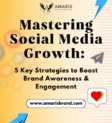
Brand Strategy to Grow Your Business: A Roadmap to Success
A properly executed brand strategy can change the face of your business and boost growth. Branding focuses on how you build and strengthen your company’s relationships with the audience, value proposition, and perception management. Powerful brands will differentiate you from competitors and enable you to cultivate customer loyalty while ensuring success over the long run. Here’s a look at how you can brand strategically to drive business growth:
Brand Strategy – Step by Step:
1. Craft a Brand Identity
Vision and Mission: State precisely the objectives of the business and its purpose. What would the world look like if your ideas could make the desired impact, and why does your brand exist? Learn more about defining your vision and mission for success.
Core Values: Derive the principles from the audience that will inform the decisions of the business. These ideals inform culture within the company branding and connectivity with private individuals.
Brand Voice and Personality: Settle on the style of communication you want to use such as professional, friendly, innovative, or any other. As branded voice goes, it should only be consistent across diverse channels. Read about how to develop a consistent brand voice.
2. Audience Focus
Market Research: Understand through audiences the challenges and desires regarding particular demographic areas at advanced stages. This ensures that the brand solves issues worrying people. Explore market research best practices.
Customer Personas: Draft custom profiles of the marketed customers so branding will tailor messaging for precise audiences for deeper and stronger outreach. Learn to create detailed buyer personas.
3. Create a Unique Value Proposition (UVP)
What Sets You Apart From Others?: Describe the features that make you superior—be it through quality, pricing, service, or other noteworthy characteristics.
Clarity: Simple propositions work best, especially when dealing with UVPs. See tips on crafting a compelling unique value proposition.
4. Build A Cohesive Visual Identity
Logo And Color Palette: Create a captivating logo as well as colors that compliment your brand persona and appeal to your target audience.
Typography & Brand Design: Recognition of a brand across touch points is aided through consistency in the fonts, design elements, and brand image used.
Brand Instructions: Develop style rules that will aid in maintaining uniformity visually, from the website and packaging to social media channels. Check out guidelines on visual brand consistency.
5. Utilize Your Online Presence
Website And Store: Ensure that your website serves as an online brand representation by being intuitive, easy to navigate, mobile-friendly, and aligned to your brand. Get insights on effective website branding.
Social Media: Instagram, LinkedIn, and Facebook serve as interaction forums with clientele. Do remember to customize material for each platform while keeping the brand consistent. Read more about social media branding strategies.
SEO And Content Branding: Establish search visibility and maintain brand presence by executing relevant SEO practices like creating educative and engaging content around your brand message. Learn SEO basics for branding.
6. Prioritize Customer Experience and Engagement
Brand Customer Service: Provide friendly, helpful customer support as it forever transforms first-time buyers into loyal advocates. Deliver service that meets the expectations set by the branded value matrix.
Feedback Funnel: Listen to and act on the brand’s customer feedback. Engagement demonstrates that their opinions count. Evaluation deepens and fosters brand loyalty. Learn how to create effective customer feedback loops.
7. Form Strategic Collaborations and Partnerships
Sponsorships and Events: Place sponsorships on brand-aligned clinical or non-clinical webinars and events to further your brand vision. These directly aid in establishing and/or expanding brand recognition, positioning you as an authority within the said space.
8. Brand Association Consistency Monitoring Over All Channels
Brand Communication Consistency: Maintain and align the branded message across all communication channels, customer service interactions, social media. All touchpoint user experiences need to be consistent.
Flexibility Brand Conformance: Monitor altering and shifting customer business drivers while maintaining brand conformance. Mark responsive strategic brand contiguity amidst evolving consistent brand tracking on all channels.
9. Assessment and Evaluation Reporting
Evaluate and measure brand performance through site traffic, engagement with set KPIs alongside user interaction metrics tracking. Set modified brand engagement benchmarks.
Your branding strategy should align with the market’s evolution. Consistently work on reviewing adjustments to your strategy to remain a step ahead of your competitors while staying relevant to your audience. See how to measure brand performance.
10. Prioritize Investments in Sustaining the Development of Your Brand
Brand Advocacy: Direct your energy towards maintaining enduring relationships with customers. Brand loyalists are advocates of the brand who buy repeatedly.
Involve your audience by explaining your brand’s journey which will enable them to connect emotionally. You can forge deeper connections and strengthen your brand affinity through storytelling. Discover more on brand advocacy and storytelling.
This strategic approach will help your business build a strong brand foundation, grow customer loyalty, and ensure long-term success.

